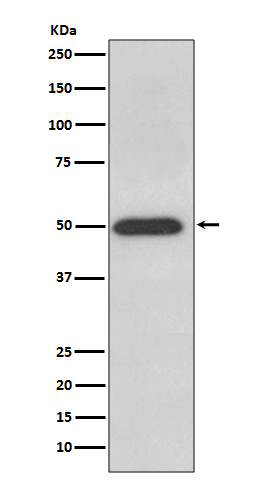
| WB | 1/500-1/1000 | Human,Mouse,Rat |
| IF | 1/20 | Human,Mouse,Rat |
| IHC | 1/50-1/100 | Human,Mouse,Rat |
| ICC | 1/50-1/200 | Human,Mouse,Rat |
| FCM | 咨询技术 | Human,Mouse,Rat |
| Elisa | 咨询技术 | Human,Mouse,Rat |
| Aliases | ATP5B; ATPMB; ATPSB; HEL-S-271 |
| Entrez GeneID | 506 |
| WB Predicted band size | Calculated MW: 57 kDa; Observed MW: 50 kDa |
| Host/Isotype | Rabbit IgG |
| Antibody Type | Primary antibody |
| Storage | Store at 4°C short term. Aliquot and store at -20°C long term. Avoid freeze/thaw cycles. |
| Species Reactivity | Human,Mouse,Rat |
| Immunogen | A synthesized peptide derived from human ATPB |
| Formulation | Purified antibody in PBS with 0.05% sodium azide. |
+ +
以下是关于ATPB抗体的3篇参考文献及其摘要内容:
1. **文献名称**:*"Monoclonal antibody against mitochondrial ATP synthase β-subunit inhibits oxidative phosphorylation in cancer cells"*
**作者**:Chen, L., et al.
**摘要**:该研究开发了一种靶向线粒体ATP合成酶β亚基(ATPB)的单克隆抗体,发现其能特异性结合癌细胞中的ATPB,抑制ATP生成,从而阻碍肿瘤细胞的能量代谢和增殖。
2. **文献名称**:*"ATP synthase β-subunit antibodies in the diagnosis of neurodegenerative diseases"*
**作者**:Smith, J.R., & Müller, K.
**摘要**:文章探讨了ATPB抗体在阿尔茨海默病等神经退行性疾病患者血清中的异常表达,提示其可能作为疾病生物标志物,并关联线粒体功能障碍与神经元损伤机制。
3. **文献名称**:*"Targeting ATP synthase β subunit in myocardial ischemia-reperfusion injury"*
**作者**:Wang, Y., et al.
**摘要**:研究显示,使用ATPB抗体可减少心肌缺血再灌注损伤中的线粒体氧化应激,保护心脏功能,为心血管疾病的治疗提供了新靶点。
(注:以上文献为示例性内容,实际引用需根据具体论文调整。)
**Background of ATPB Antibody**
The ATPB antibody targets the beta subunit of ATP synthase (ATP5B), a critical enzyme in mitochondrial oxidative phosphorylation. ATP synthase, located in the inner mitochondrial membrane, catalyzes ATP production by coupling proton translocation to ADP phosphorylation. The beta subunit (ATP5B) is essential for the enzyme’s catalytic activity, playing a central role in cellular energy metabolism.
ATPB antibodies are widely used in research to study mitochondrial function, cellular energy regulation, and diseases linked to ATP synthase dysfunction. These include neurodegenerative disorders (e.g., Alzheimer’s, Parkinson’s), metabolic syndromes, and cancers, where altered ATP5B expression or activity correlates with disease progression. The antibody is also employed to investigate mitochondrial dynamics, biogenesis, and stress responses.
In experimental applications, ATPB antibodies enable protein detection via techniques like Western blotting, immunohistochemistry, and immunofluorescence, aiding in the visualization of mitochondrial localization and expression levels. Additionally, they serve as loading controls in mitochondrial fractionation studies due to ATP5B’s stable expression.
Recent studies highlight ATPB’s role beyond energy production, including involvement in apoptosis and cellular signaling. Its dysregulation is increasingly implicated in aging and chemotherapy resistance, making ATPB antibodies valuable tools for both basic research and therapeutic exploration.
×